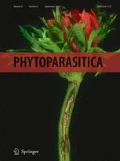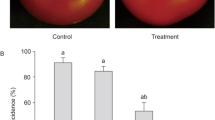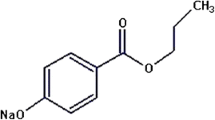Abstract
Difluoromethylornithine (DFMO) — an inhibitor of polyamine biosynthesis, and the polyamine spermidine (Spd) reduced gray mold of tomato, pepper, eggplant, bean andSenecio sp. leaves, and of rose petals by 37–88% when applied at 0.1–1.0 mM each. Higher doses did not result in better control. The disease was also reduced significantly on tomato fruits by 1.0 inM DFMO and by 0.1–1.0 mM Spd, and on cucumber fruits by 0.1–1.0 mM of both compounds, but not on grape berries. The combination of 0.2 mM DFMO with 1.0 mM Spd controlled gray mold ofSenecio sp. and tomato leaves additively better than either treatment alone, whereas this effect was not observed in leaves of lettuce and pepper. Ethylene production was reduced significantly by Spd applied to leaves of tomato and pepper, but not by DFMO. Linear growth and germination of the fungus were affected by lower concentrations of DFMO (ED50 0.12–0.97 and 1.4, respectively) as compared with Spd. Spermidine and DFMO controlled white mold(Sclerotinia sclerotiorum) as effectively as did the fungicide benomyl.
Similar content being viewed by others
References
Adams, D.O. and Yang, S.F. (1977) Methionine metabolism in apple tissue. Implication of S-adenosylmethionine as an intermediate in the conversion of methionine to C2H4.Plant Physiol. 60:892–896.
Adams, D.O. and Yang, S.F. (1979) Ethylene biosynthesis: identification of 1-aminocyclopropane-1-carboxylic acid as an intermediate in the conversion of methionine to ethylene.Proc. Nat. Acad. Sci. U.S.A. 76:170–174.
Apelbaum, A., Burgoon, A.C., Anderson, J.D., Lieberman, M., Ben-Arie, R. and Mattoo, K. (1981) Polyamines inhibit biosynthesis of ethylene in higher plant tissue and fruit protoplasts.Plant Physiol. 68:453–456.
Archer, S.A. and Hislop, E.O. (1975) Ethylene in host-pathogen relationships.Ann. Appl. Biol. 81:127–126.
Arnoldi, A., Caughi, M., Farina, G., Merlini, L. and Marrino, M.G. (1989) Synthetic analogs of phytoalexins. Synthesis and antifungal activity of potential free-radical scavengers.J. Agric. Food Chem. 37:508–512.
Drolet, G., Dumbroff, E.B., Legge, R.L. and Thompson, J.E. (1986) Radical scavenging properties of polyamines.Phytochemistry 25:367–371.
Edlich, U., Lorenz, G., Lyr, H., Nega, E. and Pommer, E.H. (1989) New aspects on the infection mechanism ofBotrytis cinerea Pers.Neth. J. Plant Pathol. 95(suppl. 1):53–62.
Elad, Y. (1987) Ultrastructural scanning electron microscopical study of parasitism ofBotrytis cinerea on flowers and fruit of cucumber.Trans. Br. Mycol. Soc. 97:185–190.
Elad, Y. (1988) Involvement of ethylene in the disease caused byBotrytis cinerea on rose and carnation flowers and the possibility of control.Ann. Appl. Biol. 113:589–598.
Elad, Y. (1990) Production of ethylene by tissues of tomato, pepper, French-bean and cucumber in response to infection byBotrytis cinerea.Physiol. Mol. Plant Pathol. 36:277–287.
Foster, S.A. and Walters, D.R. (1990) The effects of polyamine biosynthesis inhibitors on mycelial growth, enzyme activity and polyamine levels in the oat-infecting fungusPyrenophora avenae.J. Gen. Microbiol. 136:233–239.
Galston, A.W. and Sawbucy, R.K. (1990) Polyamines in plant physiology.Plant Physiol. 94:406–410.
Goodman, R.N., Kiraly, Z. and Wood, K. (1986) The Biochemistry and Physiology of Plant Disease. University of Missouri Press, Columbia, MO.
Liberman, M. (1975) Biosynthesis and action of ethylene.Annu. Rev. Plant Physiol. 30:533–591.
McNicol, R.J., Williamson, B. and Young, K. (1989) Ethylene production by black currant flowers infected byBotrytis cinerea.Acta Hortic. 262:209–215.
Metcalf, B.W., Bey, P., Danzin, C, Jung, M.J., Carsara, P. and Vevert, J.P. (1978) Catalytic irreversible inhibition of mammalian ornithine decarboxylase (E.C. 4.1.1.17) by substrate and product analogs.J. Am. Chem. Soc. 100:2551–2553.
Mussell, H., Osmeloski, J., Wettlaufer, S.H. and Weinstein, L. (1987) Suppression of Verticillium wilt of tomato by difluoromethylornithine, a suicidal inhibitor of polyamine biosynthesis.Plant Dis. 71:313–316.
Prusky, D. (1988) The use of antioxidants to delay the onset of anthracnose and stem end decay in avocado fruits after harvest.Plant Dis. 7:381–384.
Rajam, M.V. and Galston, A.W. (1985) The effect of some polyamine biosynthetic inhibitors on growth and morphology of phytopathogenic fungi.Plant Cell Physiol. 26:683–692.
Rajam, M.V., Weinstein, L.H. and Galston, A.W. (1985) Prevention of a plant disease by specific inhibition of fungal polyamine biosynthesis.Proc. Nat. Acad. Sci. U.S.A. 82:6874–6878.
Rajam, M.V., Weinstein, L.H. and Galston, A.W. (1986) Kinetic studies on the control of the bean rust fungus(Uromyces phaseoli L.) by an inhibitor of polyamine biosynthesis.Plant Physiol. 82:485–487.
Smith, T.A. (1975) Recent advances in the biochemistry of plant amines.Phytochemistry 14:865–890.
Smith, T.A., Bakker, J.H.A. and Jung, M. (1990) Growth inhibition ofBotrytis cinerea by compounds interfering with polyamine metabolism.J. Gen. Microbiol. 136:985–992.
Smith, T.A., Bakker, J.H.A. and Jung, M. (1990) Effect of enzyme-activated inhibitors on ornithine decarboxylase and growth ofBotrytis cinerea.Phytochemistry 29:1759–1762.
Suttle, J. (1981) Effect of polyamines on ethylene production.Phytochemistry 20:1477–1480.
Walters, D.R. (1986) The effects of a polyamine biosynthesis inhibitor on infection ofVicia faba L. by the rust fungus,Uromyces vicia-fabae (Pers.) Schroet.New Phytol. 104:613–619.
Walters, D.R. (1989) Polyamines and plant disease.Plants Today (Jan.-Feb. 1989): 22–26.
Walters, D.R. and Kingham, G. (1990) Uptake and translocation of α-difluoromethylornithine, a polyamine biosynthesis inhibitor, by barley seedlings: effects on mildew infection.New Phytol. 114:659–665.
Wang, C.Y. and Baker, J.F. (1980) Extending vase life of carnation with aminooxyacetic acid, polyamines, EDU, and CCCP.HortScience 15:805–806.
Weinstein, L.H., Osmeloski, J.F., Wettlaufer, S.H. and Galston, A.W. (1987) Protection of wheat against leaf and stem rust and powdery mildew diseases by inhibition of polyamine metabolism.Plant Sci. 51:311–316.
West, H.M. and Walters, D.R. (1988) The effects of polyamine biosynthesis inhibitors on infection ofHordeum vulgare L. andErysiphe graminis f.sp.hordei Marchal.New Phytol. 110:193–200.
Author information
Authors and Affiliations
Additional information
Contribution from the Agricultural Research Organization. No. 3195-E, 1991 series.
Rights and permissions
About this article
Cite this article
Elad, Y. An inhibitor of polyamine biosynthesis — Difluoromethylornithine — and the polyamine spermidine for the control of gray mold(Botrytis Cinerea) . Phytoparasitica 19, 201–209 (1991). https://doi.org/10.1007/BF02981118
Received:
Revised:
Issue Date:
DOI: https://doi.org/10.1007/BF02981118




